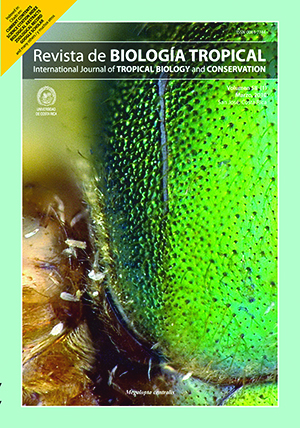Resumen
Lugares susceptibles a perturbaciones naturales o antrópicas pueden recuperar la cobertura boscosa. La sucesión tropical puede ser afectada por factores tales como perturbaciones, distancia al bosque original, topografía y clima local. Estos factores determinan la composición de especies y la tasa de recuperación de los sitios. Se estudió la sucesión en suelos que habían sido usados para el establecimiento de pasturas ganaderas por varias décadas en la Región Porce de Colombia (bosques Colombianos de los Andes). Se midieron un total de veinticinco parcelas, incluyendo nueve parcelas (20x50m) en bosques primarios y dieciséis (20x25m) en bosques secundarios. Se midieron todos los árboles con un diámetro =1.0cm. Se analizó la densidad, área basal, biomasa aérea y riqueza de especies, en un bosque con un proceso sucesional de ca. 43 años y en un bosque primario. Las edades de los bosques secundarios fueron obtenidas en estudios previos usando la datación con carbono catorce (C14), fotografías aéreas y el análisis de imágenes de satélite de alta resolución (entre 7 y > 43 años). En total, 1 143 y 1 766 individuos se midieron en bosque primario y secundario, respectivamente. El área basal (5.7 a 85.4m2ha-1), la biomasa aérea (19.1 a 1 011.5 t ha-1) y la riqueza de especies (4 a 69) aumentaron directamente con la edad de los sitios, mientras que la densidad de árboles disminuyó (3 180 a 590). Las distribuciones diamétricas fueron en J-invertida para los bosques primarios y unimodal para los secundarios. Tres especies de palmas fueron abundantes y exclusivas de bosques secundarios viejos y bosques primarios: Oenocarpus mapora, Euterpe precatoria y Oenocarpus bataua. Cohortes de estas palmas aparecieron después de perturbaciones del bosque. La recuperación de la estructura de los bosques secundarios en más de 43 años de sucesión fue 40% e indica que varios factores están interactuando y afectando la sucesión de los bosques en el área (e.g. agricultura, ganadería extensiva, minería, etc.).
Esta obra está bajo una licencia internacional Creative Commons Atribución 4.0.
Derechos de autor 2010 Revista de Biología Tropical
Descargas
Los datos de descargas todavía no están disponibles.

